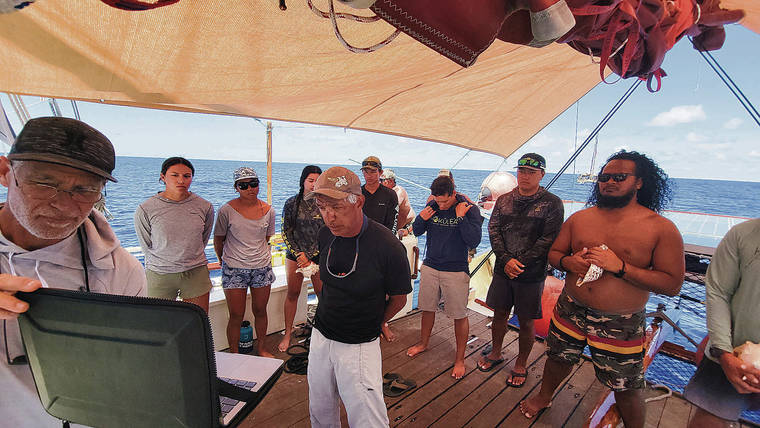Crew members of the Hikianalia voyaging canoe discovered two large anchors and two pots Wednesday while surveying Lalo, or the French Frigate Shoals.
The survey, which is being conducted by crew members of both the Hikianalia and Hokule‘a canoes in partnership with the National Oceanic and Atmospheric Administration, is the first marine survey of the area surrounding Lalo since Hurricane Walaka hit in 2018.
The anchors were found in approximately 20 feet of water in Lalo’s 14-mile-wide lagoon. Circumstantial evidence suggests that the crew’s find may have been part of an 1800s whaling ship located near the area where the Two Brothers ship from Nantucket, Mass., was identified by NOAA maritime archaeologists in 2010.
NOAA research coordinator and Hokule‘a crew member Randy Kosaki said that it might take another two years for NOAA archaeologists to return to Lalo and further investigate.
“We’re here to explore and it’s exciting that our canoes are participating in the process of discovery with NOAA, one of the greatest stewards of this place,” Polynesian Voyaging Society President and “pwo” navigator Nainoa Thompson said Friday in a news release. “The experts from NOAA say it’s a significant archaeological site. To feel like we’re helping and contributing to the body of knowledge of the ocean and this place is a privilege and a gift to those voyaging these canoes.”
The area of the Two Brothers shipwreck near the discovery is designated as a site on the state and national historic registers.
“This discovery links traditional voyaging and early-modern seafaring across time,” said Athline Clark, NOAA’s superintendent for the Papahanaumokuakea Marine National Monument, in the news release. “Hokule‘a used traditional Native Hawaiian navigational skills to voyage to the site and connect to an early American seafaring vessel.”
Additionally, according to Kosaki, the crew found near-complete destruction of some of the outer coral reefs and intermediate levels of disturbance and destruction inside the lagoon. Kosaki also said the crew saw many juvenile corals that have recruited, or begun growing into larger, adult corals, since the storm.
“The take-home message there is that in the absence of other human anthropogenic impacts, coral reefs and nature in general, left to themselves, can recover from these impacts. We just need to give them the space and time to do it,” Kosaki said Thursday in a video release.
The voyaging canoes are expected to arrive in Nihoa this morning. The canoes left Lalo on Wednesday and passed Mokumanana the next morning.
The Hokule‘a and Hikianalia are on their “Navigating the Kupuna Islands” voyage, the second deep-sea training sail preparing crew members for the Moananuiakea Voyage, a 42-month, 41,000-mile journey around the Pacific that will reach 46 countries and archipelagos, almost 100 Indigenous territories and 345 ports.




